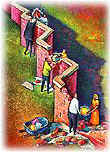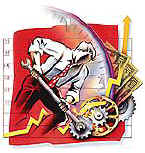|
|
Top |
|
Leader to Leader |
| Home | About the Institute | Work | Knowledge Center | Collaboration |
| Thought Leaders Forum | Leader to Leader Journal | Books and Videos | Innovation Discovery Site | |
| Joseph Neubauer:
Five Pilars
for Leading the Client-Focused Organization What's the secret for building enduring client relationships? How do you make these relationships the cornerstone of your company’s reputation in the eyes of employees and investors as well as clients? And how do you avoid being overtaken and marginalized by shifting competitive forces to consistently offer superior value to clients? During 20 years as a chief executive, my answer to these questions has never been so simple or emphatic as it is today. It consists of five precepts or pillars: Surround yourself with good people. Invest in them. Listen to them. Align culture and mission. And keep your commitments. More...
|
John P. Kotter: Winning at Change No organization today -- large or small, local or global -- is immune to change. To cope with new technological, competitive, and demographic forces, leaders in every sector have sought to fundamentally alter the way their organizations do business. These change efforts have paraded under many banners -- total quality management, reengineering, restructuring, mergers and acquisitions, turnarounds. Yet according to most assessments, few of these efforts accomplish their goals. Fewer than 15 of the 100 or more companies I have studied have successfully transformed themselves. The particulars of every case vary, but I have found that the change process involves eight critical stages. Mismanaging any one of these steps can undermine an otherwise well conceived vision, but four mistakes in particular are the source of most failures. More... |
|
Managing Knowledge Means Managing Oneself by Peter F. Drucker In a few hundred years, when the history of our time will be written from a long-term perspective, it is likely that the most important event historians will see is not technology, not the Internet, not e-commerce. It is an unprecedented change in the human condition. For the first time -- literally -- substantial and rapidly growing numbers of people have choices. For the first time, they will have to manage themselves. And society is totally unprepared for it. More..
|
Henry Mintzberg: Managing Quietly Quiet management is about thoughtfulness rooted in experience. Words like wisdom, trust, dedication, and judgment apply. Leadership works because it is legitimate, meaning that it is an integral part of the organization and so has the respect of everyone there. Tomorrow is appreciated because yesterday is honored. That makes today a pleasure. Indeed, the best managing of all may well be silent. That way people can say, "We did it ourselves." Because we did. More...
|
 |
|
John Kotter: The Power of Feelings An Interview with John P. Kotter. All through our lives we have been taught to over-rely on what you might call the memo approach -- the 19 logical reasons to change -- and we've under-relied on what Dan Cohen and I found is much more effective, which is presenting something that is emotionally compelling. People change their behavior when they are motivated to do so, and that happens when you speak to their feelings. Nineteen logical reasons don't necessarily do it. You need something, often visual, that helps produce the emotions that motivate people to move more than one inch to the left or one inch to the right. Great leaders are brilliant at this. They tell the kind of stories that create pictures in your mind and have emotional impact. Imagine, someone once told me, if Martin Luther King Jr. had stood up there in front of the Lincoln Memorial and said, "I have a business strategy." King didn't do that. He said, "I have a dream," and he showed us what his dream was, his picture of the future. You get people to change less by giving them an analysis that changes their thinking than by showing them something that affects their feelings. More... |
Charles Handy: Elephants and Fleas: Is Your Organization Prepared for Change? CEOs are not naturally inclined to look to Chairman Mao for inspiration, but Mao's insistence on the need for constant reinvention is something they need to contemplate, albeit without Mao's ruthless methods, if their organizations are going to survive in a turbulent and changing world. Reinvention, however, is easier to call for than to accomplish. For one thing, it is subject to the dilemmas of the Sigmoid Curves. More... |
| Gary Hamel:
Innovation as a Deep Capability It is well understood that in today's world of discontinuous change, there is no continuity without constant renewal. At Strategos, we conducted a survey and found that more than 90 percent of large organizations are committed to innovation, as evidenced by a recent annual report or speech in which top management affirmed innovation as a critical capability for the organization. Yet when we asked people inside these companies to describe their corporate innovation system, almost none of them could do it. And when we asked them, "Is innovation rhetoric or reality?" they said overwhelmingly, "It's rhetoric. We don't see the reality." How do we explain this gap between word and deed? One explanation is that top management is just paying lip service to innovation and has no intention of really working hard on it. But another -- and far more likely -- explanation is that senior leaders do not have a clear, well-developed model of what innovation looks like as an organizational capability. And since they don't know what it looks like, they don't know how to build it. More...
|
Frances Hesselbein:
The Art of
Listening The person who had the greatest impact upon my life, my career, and my work was my grandmother. People always expect me to talk about John W. Gardner, Peter Drucker, Warren Bennis, or Jim Collins -- all the great thought leaders who have been part of my journey. They all have had a powerful impact upon my life and my work. Yet from my first consciousness of relations with other people my grandmother has been my leadership model. She listened very carefully. More...
|
| Michael Hammer:
Why Leaders
Should Reconsider Their Measurement Systems The chaotic state of contemporary measurement was impressed upon me when I attended a senior executive meeting of a major electronics company, at which the company's leaders were carefully reviewing their dozen or so key performance measures. More...
|
Max De Pree:
Creative
Leadership King Lear tells us that nothing comes from nothing. So do scientists, for that matter. Everything in the world already exists; whatever seems new is only something old rearranged. So how do we explain innovation? The relatively short history of the United States glistens with innovation. Our open meritocracy has bred and nurtured innovative people with new ideas. Leaders in all sorts of organizations want desperately to encourage creative, innovative persons. More...
|
| Peter F. Drucker:
The New
Pluralism Leadership beyond the walls. We know that this integration can be achieved. In fact there are already a good many success stories. What is needed is for leaders of all institutions to take leadership responsibility beyond the walls. They have to lead their own institutions and lead them to performance. This requires single-minded concentration on the part of the institution. But at the same time the members of the institution -- and not just the people at the top -- have to take community responsibility beyond the walls of their own institution. More...
|
Peter F. Drucker:
Civilizing
the City Only the social sector, that is, the nongovernmental, nonprofit organization, can create what we now need, communities for citizens -- and especially for the highly educated knowledge workers who increasingly dominate developed societies. One reason for this is that only nonprofit organizations can provide the enormous diversity of communities we need -- from churches to professional associations, from organizations taking care of the homeless to health clubs -- if there are to be freely chosen communities for everyone. The nonprofit organizations also are the only ones that can satisfy the second need of the city, the need for effective citizenship for its people. Only social-sector institutions can provide opportunities to be a volunteer, and thus enable individuals to have both a sphere in which they are in control and a sphere in which they make a difference. The 20th century, now coming to an end, has seen an explosive growth of both government and business -- especially in the developed countries. What the dawning 21st century needs above all is equally explosive growth of the nonprofit social sector in building communities in the newly dominant social environment, the city. More...
|
| Peter F. Drucker:
The Shape of
Things to Come An Interview with Peter F. Drucker People always seem to be responding to change after it has happened. What advice do you give on how to anticipate change? Look out the window. Literally. You know how painters are traditionally taught painting? The teacher places a flower vase, which looks deceptively simple to paint, on the table and tells the youngster to paint the vase. The teacher comes and looks at it and says turn around, bend down, look at what you have painted upside down through your legs. That is the traditional way to teach to see. So look at our assumptions about technology or markets -- suppose the opposite were true. Is there any evidence? Challenge your assumptions. This is basically looking at the vase upside down. Make yourself capable of doing this by building organized abandonment into your system. By asking yourself every few years, If we weren't doing what we now do, would we want to start doing it? And if the answer is "probably not," then maybe it isn't the right thing to do anymore. This is not very difficult. It's a habit more than a skill. But it's a habit you have to practice. More...
|




